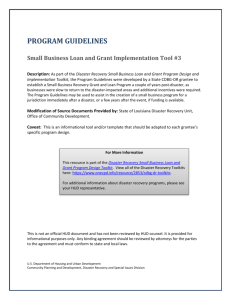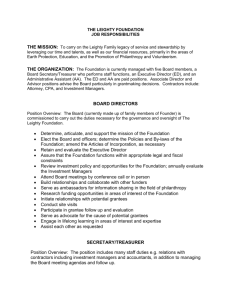Disaster Recovery Multifamily Rental Rental Dev
advertisement
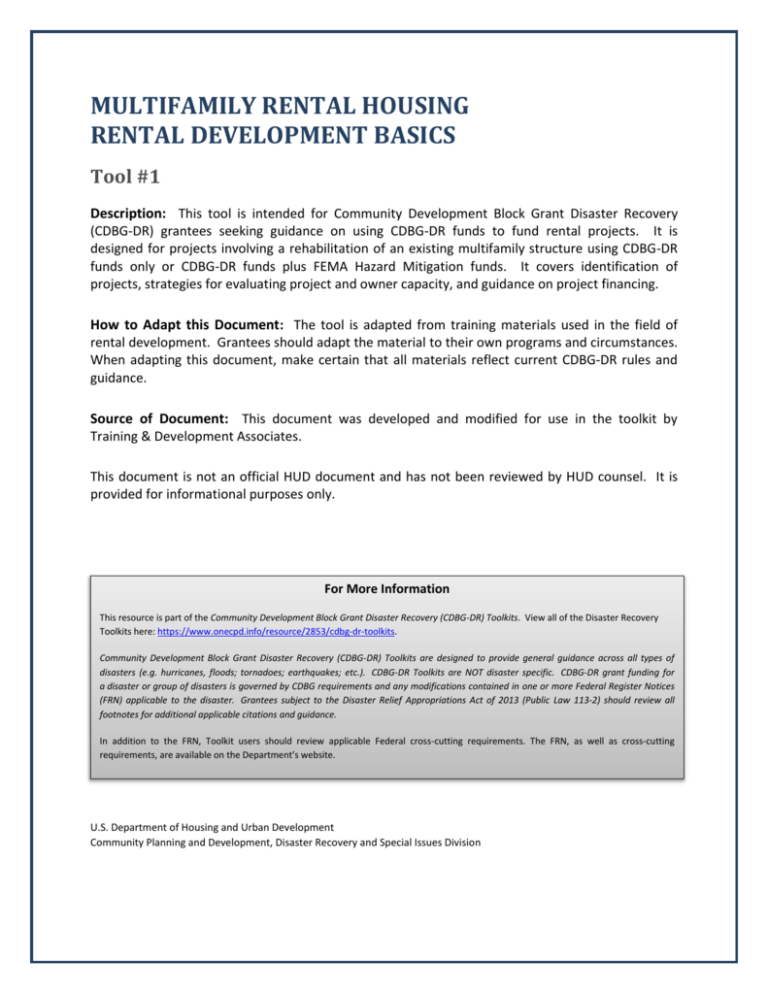
MULTIFAMILY RENTAL HOUSING RENTAL DEVELOPMENT BASICS Tool #1 Description: This tool is intended for Community Development Block Grant Disaster Recovery (CDBG-DR) grantees seeking guidance on using CDBG-DR funds to fund rental projects. It is designed for projects involving a rehabilitation of an existing multifamily structure using CDBG-DR funds only or CDBG-DR funds plus FEMA Hazard Mitigation funds. It covers identification of projects, strategies for evaluating project and owner capacity, and guidance on project financing. How to Adapt this Document: The tool is adapted from training materials used in the field of rental development. Grantees should adapt the material to their own programs and circumstances. When adapting this document, make certain that all materials reflect current CDBG-DR rules and guidance. Source of Document: This document was developed and modified for use in the toolkit by Training & Development Associates. This document is not an official HUD document and has not been reviewed by HUD counsel. It is provided for informational purposes only. For More Information This resource is part of the Community Development Block Grant Disaster Recovery (CDBG-DR) Toolkits. View all of the Disaster Recovery Toolkits here: https://www.onecpd.info/resource/2853/cdbg-dr-toolkits. Community Development Block Grant Disaster Recovery (CDBG-DR) Toolkits are designed to provide general guidance across all types of disasters (e.g. hurricanes, floods; tornadoes; earthquakes; etc.). CDBG-DR Toolkits are NOT disaster specific. CDBG-DR grant funding for a disaster or group of disasters is governed by CDBG requirements and any modifications contained in one or more Federal Register Notices (FRN) applicable to the disaster. Grantees subject to the Disaster Relief Appropriations Act of 2013 (Public Law 113-2) should review all footnotes for additional applicable citations and guidance. In addition to the FRN, Toolkit users should review applicable Federal cross-cutting requirements. The FRN, as well as cross-cutting requirements, are available on the Department’s website. For additional information about disaster recovery programs, please see your HUD representative. U.S. Department of Housing and Urban Development Community Planning and Development, Disaster Recovery and Special Issues Division Rental Development Basics: A Primer for Funding Rental Housing Projects Introduction This primer provides tools and information for grantees and their partners who are new to disaster recovery rental housing projects. The information and tools in this packet are basic materials to help establish a rental housing assistance program for disaster victims. The Community Development Block Grant (CDBG) Program Rule requires grantees to expend no less than 70 percent of their grant award for activities which support the recovery of households at or below 80 percent of Area Median Income (AMI). The Federal Register Notice(s) (FRN(s)) accompanying a Community Development Block Grant-Disaster Recovery (CDBG-DR) appropriation often modifies the program rule to require grantees to expend no less than 50 percent of their grant award for activities which support the recovery of households at or below 80 percent of AMI. In addition, the FRN will sometimes modify the program rule to allow expenditures on households up to 120% of AMI In a disaster, grantees are often faced with a broad mixture of unmet needs which complicate the grantee’s ability to meet the low- and moderate-income (LMI) requirement. Infrastructure damage is often located outside an LMI area; single family homes damaged by the disaster may be located in areas with AMI’s of 80% to 120% or higher; public facility projects and commercial revitalization projects may have few, if any impacts on LMI households. For the grantee, the nature of multifamily rental housing provides an opportunity to meet the LMI requirement while creating greater flexibility within CDBG-DR programs to meet the other unmet needs identified in the CDBG-DR Action Plan. Users of this primer might also want to review the full set of Multifamily Rental Toolkit items available, as some of those are likely to be useful. Tools available include: Creating a CDBG-DR-Eligible Rental Project. Guidance on the eligibility considerations and financing methodologies available to the grantee in responding to a disaster, and Multifamily Rental RFPs – a sample of a project specific RFP and a non-project specific RFP. Project Identification To find CDBG-DR eligible projects, grantees should utilize the unmet needs assessment process required for creating the initial CDBG-DR Action Plan. This process allows the grantee to obtain a first look at proposed rehabilitation and mitigation/resiliency projects that were directly affected by the disaster. FEMA can provide base information. The grantee should solicit initial damage reports and cost estimates for projects from private sector owners, non-profit owners, public housing authorities, and units of local government. The FRN generally requires the grantees to pay special attention to public housing authorities, transitional housing, and transitional to permanent housing In soliciting projects for the unmet needs assessment the grantee should seek a base set of information including: Type of owner (private sector, public housing, non-profit) Whether or not the owner contacted and registered with FEMA Project Location Number of Units Number of affected units Number of units targeted at or below 80% of area median income Relocations or displacement caused by the disaster Estimated costs of rehabilitation Whether or not the project is located in an environmentally sensitive area (i.e.: on a fault line; in a 100 year flood plain, etc.) Estimated costs of mitigation or resiliency The unmet needs defined by the Action Plan process provide the grantee with a base roadmap for both the likely types of rental housing programs which are needed to respond to the disaster and a rough estimate of the costs to complete Examples of types of rehabilitation that typically occur in a disaster include Repair or rehabilitation of buildings and units where the insurance and other benefit payments did not allow the owner to fully rehabilitate the property; Repair or rehabilitation of buildings and units where the insurance and other benefit payments did not allow the owner to fully rehabilitate the property and the property needs hardening or other mitigation or resiliency measures to mitigate the potential impact of future disasters; The relocation of buildings and units where environmental requirements or the property’s location suggest the new construction of units on a site out of the environmentally sensitive area is a more feasible option than mitigating in place; The reconstruction of buildings and units on the same lot in substantially the same manner. For example, reconstruction may be utilized when the rehabilitation cost exceeds 75 percent of the after rehabilitation value. The number of housing units on the lot may not be increased as part of a reconstruction; however, the number of rooms in a unit may be increased or decreased. The number of housing units on the lot may be decreased to reduce density; however, a decrease in units may require one to one replacement. Reconstruction requires an environmental review (cannot be categorically excluded); green building, energy efficiency, mitigation and/or resiliency measures are all required In addition to the directly damaged units the grantee may have a demonstrable need for new affordable units to increase the overall supply of units in the community. The unmet needs assessment informs the grantees choice of programmatic activity in the CDBGDR Action Plan. The grantee must also meet the specific requirements of the Federal Register Notice for the disaster in developing the CDBG-DR Action Plan. Applications, Requests for Proposals/Qualifications Once the Action Plan is approved, grantees may use their existing process for issuing Requests for Proposals (RFPs) / Requests for Qualifications (RFQs). Grantees should review the applicable FRN for any additional requirements relating to procurement and contracting. Also, grantees are advised to review similar documents published by other communities as well as any samples on the One CPD Resource Exchange. Most CDBG-DR project based activities will require a RFP, while activities supporting pre-development, feasibility, or other services will require a RFQ. Responses to a damaged housing rental project RFP will be wide ranging, diverse in scope, size, and applicant type. Typically, grantees can expect three types of CDBG-DR applicants: 1. Partners: Units of local government 2. Owners: Owners of damaged units 3. Developers: Developers who have partnered with an owner or who are seeking funds for new affordable housing. Basic recommendations for this process include the following: 1. Encourage owners with no or limited capacity to partner with developers. 2. Share information early and often with owners, developers, and other partners regarding the rules related to CDBG-DR projects. Be sure to provide guidance on the duplication of benefit requirements, timeliness requirements, affordability requirements, and the environmental requirements. 3. The CDBG-DR Program permits grantees and developers to expend program delivery funds for the work of assessing projects and carrying out feasibility analyses. Grantees may opt to provide reimbursement for environmental; architectural and engineering; relocation planning; or other services1. Alternatively, the grantee may use an RFQ process to procure environmental, architectural, engineering, and other services for all potential applicants. The flexibility provided by CDBG-DR allows the grantee to assist owners and developers in realistically assessing damages, costs, and timeframes. 4. An RFP for rental housing projects requires knowledge of both finance and development. For small owners, these skills may be lacking. Grantees should provide technical assistance to small owners, which is an eligible CDBG-DR expense. 5. In developing RFPs for rental housing projects the grantee should consider a universal application with sub applications. The universal application contains the threshold requirements, while the sub-applications are type specific. A Table is provided in Appendix 1 to illustrate. 6. In developing the RFPs, the grantee must include the elements defined by the Action Plan as threshold criteria including: a. Priority to those projects in areas identified by the Action Plan as the priority areas; b. Priority to project types identified by the Action Plan; c. The definition of affordable rents by unit size; and d. All cross cutting Federal requirements 7. In developing the RFP/Qualifications the grantee should include additional elements to assist the grantee in meeting timeliness requirements. Some examples include: a. Priority to applicants who are ready to proceed; b. Priority to applicants with leverage (other sources of financing) committed; c. Priority to applicants that have demonstrated capacity; d. Priority to applicants who have prior and recent experience in working in a regulated affordable housing framework, i.e., rent and income limits and other Federal regulations. e. Priority to applicants serving LMI populations 1 See the Multifamily Rental Toolkit Non-Project Specific RFQ for two methods of helping developers to package CDBG-DR compliant rental projects. Evaluate the Applicant Grantees are advised to review responses to their RFP/RFQ thoroughly to ensure completeness and compliance. Incomplete applications should be rejected. Key questions for review are listed below. Developer/Owner/Partner Capacity Consider the owner, developer or partner organizational capability to carry out the CDBG-DR project. The capacity level may be determined by asking the following questions: Are there qualified and ready-to-work team members for all roles listed in the application? Is knowledge of CDBG-DR rules and federal regulations indicated by a correct application and a project plan that reflects full understanding of CDBG-DR, environmental review, duplication of benefits, relocation and other Federal requirements? Evaluate the Project Readiness to Proceed In CDBG-DR readiness to proceed has an immediate impact on the grantees ability to meet the timeliness requirements. To assess the owner, developer, or partners’ readiness, the grantee should have a clear set of project evaluation criteria. Readiness to proceed may be determined by asking the following questions: Is the project a CDBG-DR eligible project? (Use the “CDBG-DR Eligible Rental Projects” from the Multifamily Rental Toolkit as a resource.) Are all other financing sources committed? Is the project timeline realistic? Will the applicant be able to generate a commitment and expenditure which will result in all CDBG-DR funds being expended within the required time period? Do plans and specifications meet mitigation, resiliency, green building, and energy efficiency requirements as applicable? Is the duplication of benefits information provided complete and accurate? If the project requires relocation, is a URA compliant relocation plan included? Market Viability Determine whether the assisted project has the potential to be viable in its market area. Making such a determination may call for a market study to evaluate supply and demand in the surrounding area. Market viability may be assessed by asking the following questions: Are developer’s projections for rent, vacancy, and unit quality consistent with a market study or known market information? Are market analysis conclusions supported by the evidence presented with regard to area rents and vacancy rates? Are the properties used as market comparables truly comparable in location, unit size, and amenities, and/or are differences adequately adjusted for? Property Specific History Property specific history refers to existing damaged or destroyed rental housing only. Assess the rental project’s history by collecting and compiling details on the existing rental project’s operating history. The grantee can learn from past oversights, successes, and mistakes. What were the rent rates prior to the disaster? What was the vacancy rate prior to the disaster? Was the project burdened with high cost debt? Were there code citations, tax delinquencies, grantee liens, or other similar violations prior to the disaster? If the project had or has problems or shortcomings, does the developer have a plan for effectively dealing with the identified issues? Is the plan plausible and adequately funded? Financial Viability Determine the long-term financial viability of the project given the conditions surrounding the project. An accurate judgment of the project’s future finances may involve the following considerations: Budgeting for realistic property expenses (including quality property management, property maintenance, and sufficient replacement reserves) is essential to the longterm viability of the project. Given rent restrictions, cash flow may decline over time. A 20-year cash flow projection is important to identify potential shortfalls in future years. This primer includes a simple budgeting tool. You will also find a more developed Multifamily Underwriting Template in the Multifamily Rental Toolkit. Rents & Tenants Under CDBG-DR Consider affordable rent levels and eligible tenants. In CDBG-DR, the applicable FRN may define affordability to allow mixed income projects2. Before the project is ready for tenants to move in, grantees must consider the following CDBG-DR rules: Rents must not exceed the grantee’s definition of “affordable rents” for the full term of the affordability period. All tenants must be income qualified at the time they move in, but do NOT have to be re-certified annually. A tenant’s income may increase over time without displacement from the project, but any new tenant moving in to the project must be income qualified. If the project receives subsidies from other sources the rents must reflect the requirements of the most restrictive source of funding. Cross-Cutting Federal Requirements In addition to insuring that the project meets the basic criteria for CDBG-DR eligibility and readiness, there are other critical federal requirements that must be dealt with immediately on any project. Details for these first steps are available on the One CPD Resource Exchange. Also see the “CDBG-DR Eligible Rental Projects” in the CDBG-DR Multifamily Rental Toolkit. Tenant Protection and Uniform Relocation Act Requirements Grantees must assure that the Uniform Relocation Act requirements have been followed and that both displaced occupants and any current occupants of the project are identified. These 2 Mixed income refers to projects where a portion of households are below 80 percent of area median income (AMI) and a portion of households are above 80 percent of AMI. CDBG requires at least 51% of the units assisted be at or below 80 percent of AMI. The grantee may seek a waiver to change this requirement to a proportional investment requirement. occupants are entitled to advisory services, in the form of notices and counseling, and, possibly, assistance, under the Uniform Relocation Act. Be sure you know who these occupants are and maintain records from the inception of the project. Failure to do so can lead to unexpected and substantial costs and work later. A variety of tenant protection tools and guidance documents are available on the One CPD Resource Exchange. To browse through these resources, search keyword “tenant protection.” Affirmative Marketing Requirements Grantees may already have an affirmative marketing plan. The applicant should either mirror the grantee’s plan or develop a plan which exceeds the grantee’s criteria. Grantees should insure the grantee’s affirmative marketing plan supports the grantee’s Analysis of the Impediments to Fair Housing. Environmental Review Failure to follow the proper Environmental Review procedures can lead to the project later being deemed ineligible. Be sure that any contract includes the required clauses and that the proper steps are followed prior to the investment of CDBG-DR funds. The Environmental Review process is the responsibility of the CDBG-DR grantee, however, the applicant may be asked to provide information regarding specific features or characteristics regarding the property, including its history, past uses and the scope of the proposed redevelopment, renovations, or remodeling. A variety of environmental review tools and guidance documents are available on the One CPD Resource Exchange. To browse through these resources, search keyword “environmental review.” Structure Project Financing Project financing must take into account the projected operating expenses, the ability to repay debt attached to the project, and the likely cash flow from the project. The grantee has wide discretion in project financing. The financial structure should reflect the realities of the CDBGDR project. Basic Strategies In CDBG-DR eligible projects, the current financing structure should be taken into account in designing the CDBG-DR financing structure. In most affordable housing scenarios, it is desirable for the developer to secure a conventional first mortgage in the greatest amount feasible; however, that is not necessarily the best strategy for CDBG-DR projects. Applicants may already have a first and/or second mortgage, so the grantee should be prepared to accept a lower lien position and repayment terms which are either cash flow based or due on sale or refinance. Alternatively, the grantee may assist the applicant in a refinancing of the project to reduce the monthly cost of the overall debt and to increase the affordability of the units. In effect, the grantee can become the first mortgage lender. For smaller projects (less than 12 units), where the grantee is in a second or lower position, an affordability period coupled with a due on sale and refinance clause reduces the administrative burden for the grantee For projects assisted with significant leverage including low income housing tax credits, state housing tax credits, or housing bonds, the grantee is likely to have a very small proportion of the overall debt and should structure the grantee’s portion as a forgivable loan or grant. Projects leveraged with tax credits and/or bonds carry significant affordability restrictions which permit the grantee to rely on others for affordability compliance. The result is to reduce the grantees administrative burden. For projects requiring the relocation of units out of an environmentally sensitive area, the grantee should consider the disposition of the property where the units were originally located in the financing structure. For example, a waterfront development which is relocated to an area outside of the 100 year flood plain does not require a buyout by the grantee. The property may be sold at public auction or through a sealed bid process. The grantee can require the resulting funds be distributed in accordance with the current debt on the property with any residual funds or a proportion of residual funds being returned to the grantee or utilized to reduce the CDBG-DR investment in the relocated units. For projects in an environmentally sensitive area where mitigation and resiliency will be utilized, the grantee should work closely with FEMA to leverage CDBG-DR with the appropriate Hazard Mitigation Assistance (HMA). The HMA programs can pay up to 75 percent of the eligible mitigation and resiliency eligible costs. The Multifamily Rental Toolkit contains an underwriting template with the functionality needed for more complex projects. Additional Subsidy There are often situations where the first mortgage debt and a second mortgage provided by CDBG-DR do not fully fund the project. The balance needed may be funded with a third or lower position CDBG-DR mortgage with characteristics of either a cash flow loan or a due on sale or refinance loan. CDBG-DR funds can be used to fund an additional mortgage for the entire difference between the first mortgage and the post-renovation appraised value as long as all units meet CDBG-DR criteria. Payment Options The grantee should execute a note and a mortgage to secure repayment of their investment of CDBG-DR funds. There are three main options for repayment that a CDBG-DR grantee could use for a project: annual cash flow, required monthly, or fully forgivable/due on sale. Annual Cash Flow Payment o Grantee can require a percentage share of annual cash flow based on an annual project audit. Before entering into a cash flow loan agreement the grantee should work with the developer to define cash flow; o The two most likely options for sharing cash flow are: o One-third grantee and two-thirds owner Half grantee and half owner Such sharing is reasonable because it gives the developer some incentive to generate cash flow while still generating a potentially significant repayment to the grantee. Required Monthly Payments o If the grantee is the first mortgage lender, the grantee should require monthly payments unless the project is primarily targeted at very (50% of AMI) or extremely low income households (30% of AMI). In cases of deep targeting a fixed mortgage payment may not be a workable solution. o Monthly payments are not recommended on most second mortgages as tracking and administering the loan can be a relatively large administrative burden for a relatively small return of funds. If the grantee chooses to require second mortgage payments, the grantee should be careful to maintain a 1.2 debt coverage (including the second mortgage) to insure project viability over the affordability period; Fully Forgivable/Due on Sale o CDBG-DR does not require the grantee to receive any repayment. The Grantee may choose to make the second mortgage fully forgivable over the term of the loan, with any remaining balance due if the property is sold before the end of the term or if the property fails to comply with CDBG-DR requirements. o A typical forgiveness structure might involve no forgiveness for 10 years and then 10 percent per year for the following 10 years. Interest Rate The decision to charge interest should be based on a variety of factors. If the grantee plans to implement a forgiveness structure, then charging interest is probably unnecessary. If a grantee plans to require repayment, it might consider charging an interest rate that balances the need for program income, the capacity of the project to make payments, and the owner’s need for a positive equity position. Term of Affordability Commitment CDBG-DR does not require a term of affordability. The grantee may and should impose affordability restrictions which match the level of investment of CDBG-DR funds. The grantee may impose a longer term, which can be recorded and enforced beyond the mortgage repayment. Longer terms help maintain the availability of the affordable units. The following are common examples and suggested strategies for affordability commitments: Overview: The grantee may establish benchmarks for affordability periods based on the amount of CDBGDR funds invested on a per unit basis or a project basis. The grantee may choose to use an existing set of affordability periods such as the HOME program rule, or alternatively, the grantee may determine the affordability period on a project by project basis. Fixed Payment First and Second Mortgages If the grantee will provide a first or second mortgage with a fixed payment, the term of affordability should be at least equal to the term of the mortgage. The grantee may also include a refinance provision, requiring the owner to repay the first mortgage in any refinancing. The refinance provision insures the owner will not be able to dilute the project’s ability to repay the grantees note. Forgivable and Due on Sale Mortgages There are numerous instances where a forgivable mortgage with a due on sale or refinance clause is the most effective financing structure available. The term of affordability should mirror an equivalent period such as the first mortgage lien or other subsidy liens. When no other liens exist, the minimum affordability period should be twenty years, which is considered the useful life before a rental project will need rehabilitation. Funding Agreements In addition to a standard mortgage and promissory note to secure repayment of the CDBG-DR funds, grantees will find it helpful to execute a funding agreement with all of the particulars of the specific project. A sample project-specific written agreement is available in the Multifamily Rental Toolkit as well as several sample legal documents. It is essential that the funding agreements and legal documents reflect all the performance and compliance requirements for your project, so that any meaningful change requires approval and all requirements are enforceable on the developer and/or the property, including but not limited to: Project budget Project description, unit type, design, construction standards Rent schedule Affordability requirements Lease requirements Tenant selection criteria Compliance with state and local tenant-landlord laws Conditions for faith-based organizations Lead-Based Paint requirements Fair housing and equal opportunity provisions Fund disbursement Record keeping and reporting provisions Enforcement provisions Procedures for securing rent increases Compliance requirements, including the monitoring checklist that will be used Appendix 1: Table 1provides an overview of how Universal Application can be structured. Table 1: Universal Application Sub-Applications Rehabilitation of Rehabilitation of Rehabilitation Construction of New Units less than Units more than with Mitigation Destroyed Units Construction 51% damaged 51% damaged and/or Resiliency on a New Site Threshold Threshold Threshold Threshold Threshold Eligibility Eligibility Eligibility Eligibility Eligibility National National National National National Objective Objective Objective Objective Objective Financial Financial Financial Financial Financial Feasibility Feasibility Feasibility Feasibility Feasibility Long Term Long Term Long Term Long Term Long Term Viability Viability Viability Viability Viability Cross Cutting Cross Cutting Cross Cutting Cross Cutting Cross Cutting Federal Federal Federal Federal Federal Owner/Developer Owner/Developer Owner/Developer Owner/Developer Owner/Developer Capacity Type Specific Capacity Type Specific Capacity Type Specific Capacity Type Specific Capacity Type Specific Green Building Mitigation Demolition Land Acquisition Energy Efficiency Resiliency Land Acquisition New Construction Green Building New Construction Green Building Energy Efficiency Green Building Energy Efficiency Property Disposition Energy Efficiency
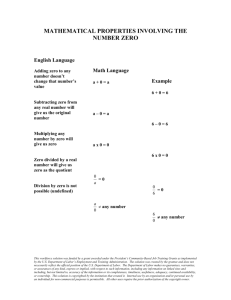
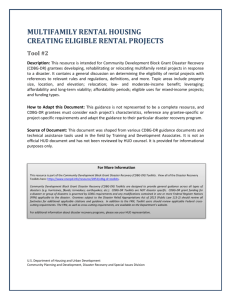
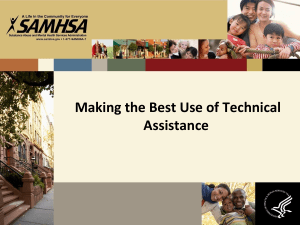
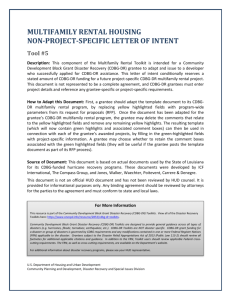
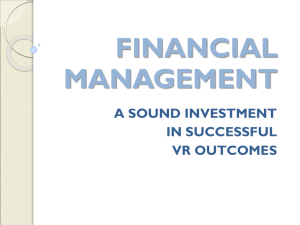
![[Educational Organizations: Universities, Colleges and Schools]](http://s3.studylib.net/store/data/005855885_1-5779bea055a993e7057979e3ec38faa7-300x300.png)
